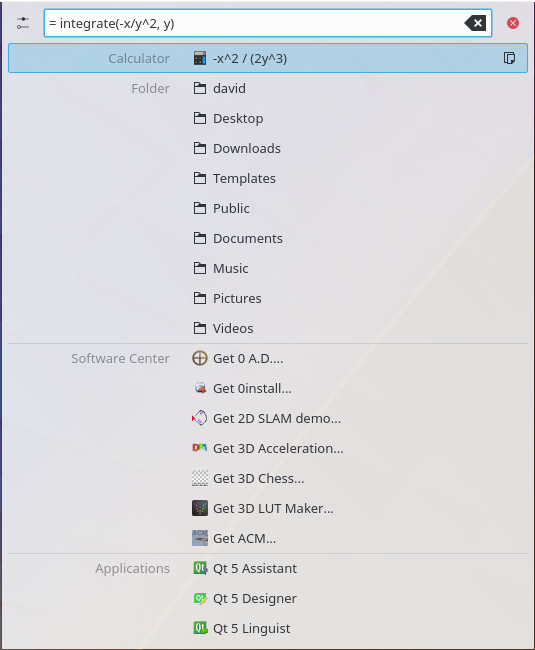Plasma/Krunner
KRunner is a tool for searching and launching files and applications. It can also be used for more generic operations such as calculator or unit converter. On most systems KRunner can be activated by pressing the Alt + F2 key combination.

Basic control
Open KRunner
There are several ways you can open KRunner:
- Press its global shortcut (Alt + F2 by default)
- Right click on your Plasma workspace and choose
- Run "krunner" command from a console
Krunner syntax
The '?' icon to the right of the entry field explains the syntax of each of the activeRunners. Scroll to see all the possible keywords and syntaxes that Runners recognise.
When search brought more than one result, you can use Tab/Tab + Shift and arrow keys to move forward and backward in result list and use Enter to select a result in addition to using mouse.
Exploring KRunner's Functions
Using as a calculator
You can use KRunner as a calculator. Just open KRunner and type the expression you want to evaluate such as 32*12= or =32*12. You can put the = sign before or after the expression.
It is possible to evaluate more sophisticated expressions such as: =sqrt(4) + 32 * sin(60)
Using as an application launcher
This you probably already knew, KRunner can also launch applications. Start Krunner (Alt + F2) and type the name of the application you want to run. For applications that appear in the applications menu, you may type a portion of the application name or keywords from its description. You may also use the names or descriptions of individual control panels to launch them.
Running BASH commands
In addition to applications KRunner also recognizes all binaries throughout your system. You can use this ability to run bash commands such as cp, mv, etc.
To do so, start KRunner (Alt + F2) and type the commands just as you would in Konsole:
cp ~/Documents/myFile ~/myFile (not a useful example but you get the idea)
Launching websites
Enter a URL - http://www.somewhere.com - and the page will pop up in your browser.
Using web shortcuts
You can also use web shortcuts with KRunner. Example: gg:some-term will bring up Google search results.
In order to use a web shortcut, first make sure it exists and is checked. You can manage them through Konqueror's configuration, Rekonq's, or try writing Web Shortcuts in KRunner.
KRunner as a unit converter
KRunner can help you convert numbers from one unit to another for area, length, mass, speed and volume in KDE SC 4.2 and currency, energy, pressure and temperature in KDE SC 4.3. For each category, a default unit is set.
Example: 6 feet in meters will output
1.8288 m
.
When you don't give the target unit, conversion is done automatically into default unit of the category.
Example: 10 acres will output
40469 m²
Controlling Power Management via PowerDevil addon
It is possible to control the various PowerDevil options via Krunner:
power profilebrings up available profiles.screen brightnessturns off or dims screen.screen brightness <percent>sets the brightness percent of the screen.suspendbrings up suspend options.power governorsets the cpu governor.power schemesets the power scheme.
Windows
This plug-in allows you to switch to windows or virtual desktops by entering its name. It matches partial window titles, application names (if it can be extracted from the window title) and virtual desktop names.
Advanced Usage with Single Runner Mode
You can use KRunner in a special mode called "Single Runner Mode", which allows you to restrict your search results to those given by a specific plug-in. For instance, you can restrict search results to the "Windows" runner and browse open windows enjoying the filtering features of the plug-in. Another example would be using the "Devices" runner so that you would be able to browse, mount or unmount devices from within KRunner.
An increasing number of plug-ins allow this mode; it is simple to activate it by assigning the corresponding shortcut via the "Global keyboard shortcuts" systemsettings module.
